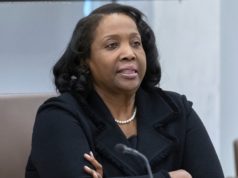What did we learn from the first week of the Bill Cosby trial and who’s winning the case?
As the second week of the Bill Cosby trial got underway with a bang Monday morning — the defense rested without calling Cosby to testify — here are six takeaways from the chockablock first week of testimony.
The secondary accuser. Kelly Johnson didn’t arrive at the stand easily. The woman who leveled accusations at Cosby based on interactions in 1996 was part of an intense pretrial battle. To get her here, the prosecution went through several days of hearings arguing that Johnson — and 12 other accusers it said were relevant — should be allowed to testify under the it’s-all-germane rule of evidence known as the Prior Bad Acts clause. Johnson was the only one admitted.
Testifying last week, Johnson was a persuasive witness for the prosecution, painting a picture of a young woman who was just trying to get by at her low-level Hollywood agency job when Cosby offered to be her mentor — then used that trust to sexually assault her in a meeting at the Bel-Air hotel. The defense did get some shots in, not least on the grounds that she led a wild lifestyle at the time — the kind of credibility attack that, while risky, can pay dividends with a jury looking for reasons not to believe someone.
The main accuser. From early on, out of the women accusing Cosby of sexual abuse, Andrea Constand was the key. After all, she was the one accuser whose statute of limitations had not run out. And she was one of a handful of accusers who hadn’t told her story fully in a written piece or TV segment.
So how did she do at the trial? The 44-year-old radiated a kind of quiet self-assurance during direct examination and was somewhat more halting on cross, with a number of long pauses and « I don’t recall » invocations. She made the case for herself as a woman who had no romantic interest in Cosby and visited his home purely platonically because she wanted his guidance. He would then proceed to act awkwardly and — ultimately, on that night, she said — abusively.
The defense tried to draw a different sketch, one in which Constand was romantically interested and also professionally motivated, looking to get Cosby’s endorsement for a household-products company she and a friend were starting. The more complicated role for Constand laid the groundwork, the defense intimated, for potential consent the night she says she was attacked.
The defense’s main victory was underscoring a date discrepancy for which Constand had little plausible response — she had initially reported the attack as happening in March, then later corrected herself that it happened two months earlier. Overall, though, they dinged her testimony relatively little, and the crucial witness stepped down from the stand with armor largely intact.
The mom. Maybe the biggest surprise of the first week was Gianna Constand. Initially thought to be a peripheral witness, at the trial mainly to establish her daughter’s state of mind, the elder Constand, it turns out, confronted Cosby after the alleged attack in significant ways. On the stand, she was forceful and unapologetic in explaining why she went after him, and she provided for the prosecution the more withering voice they did not have in Constand, especially not backing down as the defense sought to discredit her daughter. She also made a case for Andrea Constand’s fragile state of mind after the incident. The combination of vulnerability and defiance made her the strongest arrow in the prosecution’s quiver.
The experts. Toxicologist, psychologist — each played a role in the trial’s first week. The pair of expert witnesses for the prosecution sought to bolster Constand’s case against Cosby by noting why it seemed more likely to them that the accuser was telling the truth. Toxicologist Timothy Rohrig said Cosby’s claim that he had only provided Constand with Benadryl the night of the incident didn’t mitigate Constand’s claim, he argued, since the drug has a deeply sedating effect and has been used in sexual assaults. Psychologist Veronique Valliere, meanwhile, argued that Constand’s decision to wait a year before coming forward and keeping in contact with the entertainer during that time was consistent with other assault victims, who were too traumatized or too interested in stability to speak out right away.
So how did they fare? Split decision. Rohrig landed his testimony almost unimpeded. But Valliere was tripped up by a Facebook post in which she appeared to be rooting against Cosby, which the defendant’s lawyers used to objectivity-eroding effect.
The judge. Steven T. O’Neill ran a tight courtroom. He has been highly explanatory with the jury, talking about getting them home to Pittsburgh as quickly as possible, and taking a no-nonsense policy with everyone else. He often repeated admonitions about the news media reaching out to jury members and has made sure his court came down hard on disruptions — outspoken women’s rights lawyer Gloria Allred was barred from the main courtroom after her cellphone went off a second time during the trial Friday.
The examiners. One thing that’s jumped out about the prosecution is how much they’re spreading around the questions. Some might have expected Dist. Atty. Kevin Steele to handle the lion’s share of the work. But Steele has deferred on the two accusers, on Gianna Constand and on the two experts, allowing his younger Assistant Dist. Attys. Kristen Feden and M. Stewart Ryan, to take the lead; the former in particular has earned high marks. Steele himself picked up mainly the law enforcement witnesses, with whom he mostly engaged in reading Cosby’s deposition and interview testimony, a more straightforward task.
Meanwhile, the defense has split the workload between two lawyers, lead Cosby attorney Brian McMonagle and Southern California-based Angela Agrusa. The latter, in fact, cross-examined both Johnson and Andrea Constand, a decision that left many observers flummoxed. Her tentative, sometimes choppy style left Constand’s account unchallenged in several key areas and was seen by many experts following the case as a big blunder. The showman McMonagle was deemed to have been the better choice, though the defense might have preferred a woman to cross-examine the accusers.






